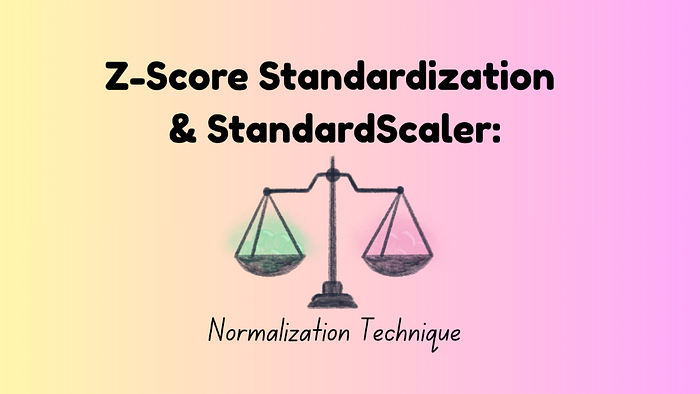Introduction to Z-Score Standardization
You’ve cleaned your data, handled missing values, and are ready to build a powerful machine learning model. But there’s one critical step left: feature scaling. If you’ve ever wondered why your K-Nearest Neighbors model performs poorly or your Neural Network takes forever to train, unscaled data is likely the culprit.
What is Z-Score Standardization?
Z-Score Standardization is a statistical method that transforms your data to have a mean of 0 and a standard deviation of 1. It’s like centering your data around zero and making the spread consistent across all features.
The Concept
To understand Z-Score Standardization, we need to understand two fundamental concepts: mean and standard deviation.
What is the Mean?
The mean (often called the “average”) is the most common measure of central tendency. It represents the typical value in your dataset.
Formula: μ = (Σx) / N
Where: μ (mu) = Mean, Σx = Sum of all values in the dataset, N = Total number of values
What is Standard Deviation?
The standard deviation measures how spread out your data is from the mean. It tells you how much variation or dispersion exists in your dataset.
Formula: σ = √[Σ(x – μ)² / (N-1)]
Where: σ (sigma) = Standard Deviation, x = Each individual value, μ = Mean of the dataset, N = Total number of values
The Mathematical Formula
The transformation is beautifully simple: z = (x – μ) / σ
Where: x = Original value, μ (mu) = Mean of the feature, σ (sigma) = Standard deviation of the feature, z = Standardized value (z-score)
Why Use Z-Score Standardization?
Z-Score standardization is crucial for algorithms that rely on distance calculations or gradient-based optimization, such as:
- Support Vector Machines (SVM)
- K-Nearest Neighbors (K-NN)
- Neural Networks
- K-Means Clustering
- Principal Component Analysis (PCA)
When to Use Z-Score Standardization
Use Z-Score Standardization when:
- Working with distance-based algorithms
- Using gradient-based optimization
- Your data is approximately normally distributed
- You need interpretable feature contributions
When Not to Use Z-Score Standardization
Consider alternatives when:
- Data has extreme outliers (use RobustScaler)
- You need specific output ranges (use MinMaxScaler)
- Working with tree-based models (often no scaling needed)
- Dealing with sparse data (use MaxAbsScaler)
StandardScaler: The Practical Implementation
Now that we understand the theory, let’s see how to implement Z-Score standardization in practice using scikit-learn’s StandardScaler.
Why Use StandardScaler Instead of Manual Calculation?
While you could implement Z-score manually, StandardScaler provides crucial advantages, including:
- Prevents Data Leakage
- Pipeline Integration
- Efficiency
- Consistency
Preventing Data Leakage
Never fit your scaler on the entire dataset! If you fit your scaler on the entire dataset (including test data), you’re “peeking” at the test set during training. This gives you overly optimistic performance estimates and models that fail in production.
Conclusion
Through this comprehensive guide, we’ve seen that Z-Score standardization is a powerful technique, but it’s not a one-size-fits-all solution. Always fit your scaler on training data only and use the same parameters to transform your test data.
FAQs
Q: What is Z-Score Standardization?
A: Z-Score Standardization is a statistical method that transforms your data to have a mean of 0 and a standard deviation of 1.
Q: Why is Z-Score Standardization important?
A: Z-Score Standardization is crucial for algorithms that rely on distance calculations or gradient-based optimization.
Q: How do I implement Z-Score Standardization in practice?
A: You can implement Z-Score Standardization using scikit-learn’s StandardScaler.
Q: What is the difference between Z-Score Standardization and other scaling methods?
A: Z-Score Standardization is different from other scaling methods, such as MinMaxScaler and RobustScaler, in that it transforms data to have a mean of 0 and a standard deviation of 1.











